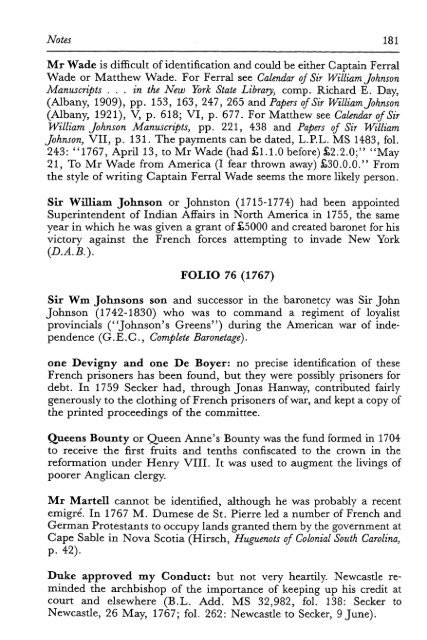Archbishop of Canterbury - KU ScholarWorks - The University of ...
Archbishop of Canterbury - KU ScholarWorks - The University of ...
Archbishop of Canterbury - KU ScholarWorks - The University of ...
You also want an ePaper? Increase the reach of your titles
YUMPU automatically turns print PDFs into web optimized ePapers that Google loves.
Notes 181<br />
Mr Wade is difficult <strong>of</strong> identification and could be either Captain Ferral<br />
Wade or Matthew Wade. For Ferral see Calendar <strong>of</strong> Sir William Johnson<br />
Manuscripts . . . in the New York State Library, comp. Richard E. Day,<br />
(Albany, 1909), pp. 153, 163, 247, 265 and Papers <strong>of</strong> Sir William Johnson<br />
(Albany, 1921), V, p. 618; VI, p. 677. For Matthew see Calendar <strong>of</strong> Sir<br />
William Johnson Manuscripts, pp. 221, 438 and Papers <strong>of</strong> Sir William<br />
Johnson, VII, p. 131. <strong>The</strong> payments can be dated, L.RL. MS 1483, fol.<br />
243: "1767, April 13, to Mr Wade (had £1.1.0 before) £2.2.0; 55 "May<br />
21, To Mr Wade from America (I fear thrown away) £30.0.0." From<br />
the style <strong>of</strong> writing Captain Ferral Wade seems the more likely person.<br />
Sir William Johnson or Johnston (1715-1774) had been appointed<br />
Superintendent <strong>of</strong> Indian Affairs in North America in 1755, the same<br />
year in which he was given a grant <strong>of</strong> £5000 and created baronet for his<br />
victory against the French forces attempting to invade New York<br />
(D.A.B.).<br />
FOLIO 76 (1767)<br />
Sir Wm Johnsons son and successor in the baronetcy was Sir John<br />
Johnson (1742-1830) who was to command a regiment <strong>of</strong> loyalist<br />
provincials ("Johnson's Greens") during the American war <strong>of</strong> independence<br />
(G. E. C., Complete Baronetage).<br />
one Devigny and one De Boyer: no precise identification <strong>of</strong> these<br />
French prisoners has been found, but they were possibly prisoners for<br />
debt. In 1759 Seeker had, through Jonas Hanway, contributed fairly<br />
generously to the clothing <strong>of</strong> French prisoners <strong>of</strong> war, and kept a copy <strong>of</strong><br />
the printed proceedings <strong>of</strong> the committee.<br />
Queens Bounty or Queen Anne's Bounty was the fund formed in 1704<br />
to receive the first fruits and tenths confiscated to the crown in the<br />
reformation under Henry VIII. It was used to augment the livings <strong>of</strong><br />
poorer Anglican clergy.<br />
Mr Martell cannot be identified, although he was probably a recent<br />
emigre. In 1767 M. Dumese de St. Pierre led a number <strong>of</strong> French and<br />
German Protestants to occupy lands granted them by the government at<br />
Cape Sable in Nova Scotia (Hirsch, Huguenots <strong>of</strong> Colonial South Carolina,<br />
p. 42).<br />
Duke approved my Conduct: but not very heartily. Newcastle reminded<br />
the archbishop <strong>of</strong> the importance <strong>of</strong> keeping up his credit at<br />
court and elsewhere (B.L. Add. MS 32,982, fol. 138: Seeker to<br />
Newcastle, 26 May, 1767; fol. 262: Newcastle to Seeker, 9 June).

















